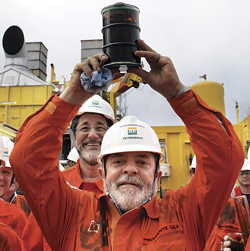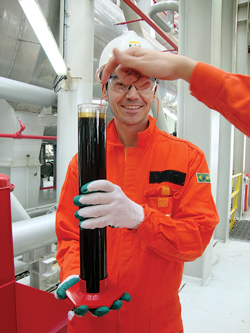Vol. 233 No. 5
Nothing crude about crude oil
|
.jpg)
|
Crude oil gets a bad rap these days as a dirty fossil fuel. You can easily imagine environmental hardliners, and uninformed citizens and politicians, recoiling in horror at the mere mention of crude oil. I may be preaching to the choir, but crude oil is an exceptional energy resource that is a mainstay of our civilization. In fact, if crude oil wasn’t available in nature, we would have to invent it.
Gasoline and diesel refined from crude oil have higher energy content than coal. Uranium-235 and hydrogen are rated higher, but it is not yet practical to drive a nuclear-powered vehicle, and a fuel cell car is still decades away. Gasoline, which is relatively stable at room temperature, is much more suited as a transportation fuel than either compressed natural gas (CNG) or liquefied natural gas (LNG).
Crude oil is the feedstock for an extensive range of light distillates from propane and butane to naptha, gasoline, diesel and kerosene. From the bottom of the crude barrel, we can extract heating oil, lubricants, paraffins, waxes, greases and asphalt.
Crude oil is also the base ingredient of more than 6,000 petrochemical products, ranging from films and plastics to paints, inks, synthetic fabric, rubber and fertilizer. When and if natural gas takes over as a transportation fuel, crude oil would still be a critical commodity for petrochemicals to sustain our modern lifestyle.
Undoubtedly, the emission of CO2 and other air pollutants is a serious problem. The U.S. Environmental Protection Agency (EPA) has just imposed a clean air mandate for upstream oil and gas production. Carbon sequestration is one solution. World Oil is currently running a series of articles on carbon sequestration technologies from the U.S. National Energy Technology Laboratory (NETL). Additionally, it would be useful to develop technology to capture the CO2 and use it to enhance plant and forest growth. That would be one way of completing the energy cycle that began with the compaction of plant and animal matter millions of years ago.
The second issue with crude oil is the price. Even if it is a valuable energy source, should crude oil cost over $100/bbl? High oil prices provide a good margin for our businesses, but the consumers are subjected to economic hardship. During the last 75 years, the price of oil has fluctuated from less than $10/bbl to $125/bbl. The upstream industry has suffered during the down cycles, so this is a compensatory revenue adjustment during an up cycle. We’re certainly getting no sympathy from the mainstream news media or the Obama administration on the precipitous drop in U.S. natural gas prices.
There are complex factors at work in determining oil prices, from basic supply and demand to the value of the U.S. dollar and commodity speculation. Neither Saudi Arabia, President Obama nor oil companies can single-handedly control the daily fluctuation of oil prices. Of course, a sound energy policy that encourages exploration would help over the long term. A North American oil and gas operator, producing both oil and gas today, would rather have oil at $80/bbl and natural gas at $10/Mcf than today’s extreme pricing situation.
So, there you have it. Crude oil is essential, expensive and a maddeningly complex component of today’s economic, political and social life. 
 |
| Former President Luiz Inacio Lula da Silva Lula celebrates first oil from the pre-salt Lula field, offshore Brazil. |
|
 |
| A toast to black liquid gold aboard the FPSO Angra dos Reis, producing from the pre-salt Lula field, offshore Brazil. |
|
|

.jpg)



